Blenheim Palace: The Grandest Private Residence that outshines the British Monarchy’s Homes
There’s more fascinating tale about Blenheim Palace than just being the birthplace and ancestral home of Prime Minister Winston Churchill. This place is steeped with formidable history and is far superior in grandeur and magnitude than any of the royal palaces in the country. Set in a 2,100 acres land, the massive 200,000 sq ft estate has 187 rooms (some of the rooms in the ground floor has 24k gold gilded ceiling), dwarfing Buckingham, the Queen’s official London residence. The magnificent palace has awed visitors for over three hundred years that even King George III exclaimed with a gasp to Queen Charlotte “We have nothing to equal this!” as they entered Blenheim’s Triumphal Arch in 1786.
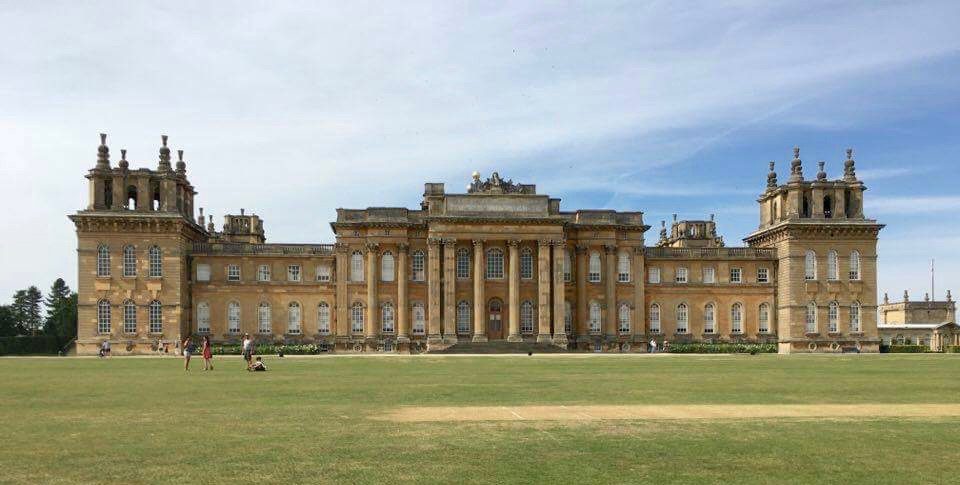
Brief History:
The foundation stone of Blenheim Palace was laid on 18th June 1705, less than a year after the heroic victory of John Churchill, the 1st Duke of Marlborough and the military commander of the allied forces, who led against the French on the fields of Blenheim, in Bavaria. The Duke was not only a very clever military strategist but he was also married to Sarah Jenyns, a friend of Queen Anne since childhood. It was no surprise therefore that after the Battle of Blenheim the Queen generously gifted the Marlboroughs the 2,100 acres Royal Manor and park at Woodstock, Oxfordshire, and the Parliament unanimously voted to provide funds to build on it a suitably palatial home. The problem was, from the outset none of the MPs (Members of Parliament), the Queen, or the Duke, thought to set a fixed budget for its construction. So to make a very long story short, the costs to build not just what the Queen intended as a national monument but also as the Marlborough family home had skyrocketed to over £240,000 (approximately £100 million in today’s money according to our tour guide) that it led the Parliament to cut off all funds in 1711. Meanwhile, the Queen dismissed Lord and Lady Churchill from court; Lady Sarah supported the Whigs when the Tories lost in the 1710 elections, and Queen Ann was a staunch Tory supporter and resisted taking in the Whigs. As a result the Marlboroughs went on self-imposed exile abroad for two years, and the construction of the palace halted. Queen Anne died while they were in exile, and Lady Sarah never saw her childhood best friend again. After the Hanoverian accession (Queen Anne died without an heir and the Saxe-Coburg Gotha — descendants of the current monarch — from Hanover, a tiny principality in Germany, were brought in to succeed the English throne), the duke and his family returned to Blenheim, and building construction of the palace resumed but it was completely on the duke’s dime. Over the next few years the duke poured in a substantial amount of money — at least £60,000 — and after his death in 1722, Lady Sarah took on the project and managed to oversee its completion in 1733. So it took twenty-eight years to complete the opulent structure, and Lady Sarah called it ‘Blenheim Palace’ to honour Queen Anne’s wishes. It is the only non-royal residence in England styled as a ‘palace.’
A House Tour:
When entering Blenheim, guests enter two awe-inspiring gates, The Triumphal Arch and East Gate, and then emerge into the Great Court area of the Palace, and finally get into the main building and enter a huge door leading to the lobby or reception called The Great Hall.
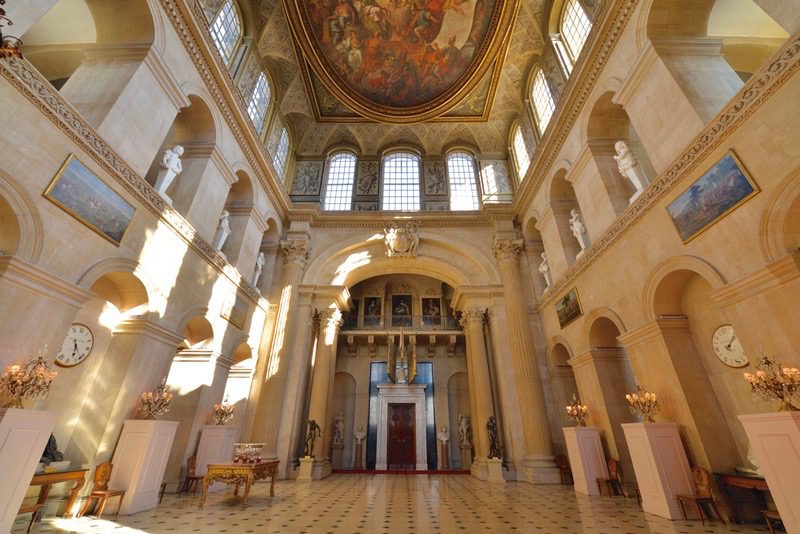
It is a remarkable space with 20 metre high ceiling painted in 1716 by Sir James Thornhill, English painter of historical subjects. The scene depicts Lord Churchill victorious and presenting to the Sovereign the plan for the Battle of Blenheim.
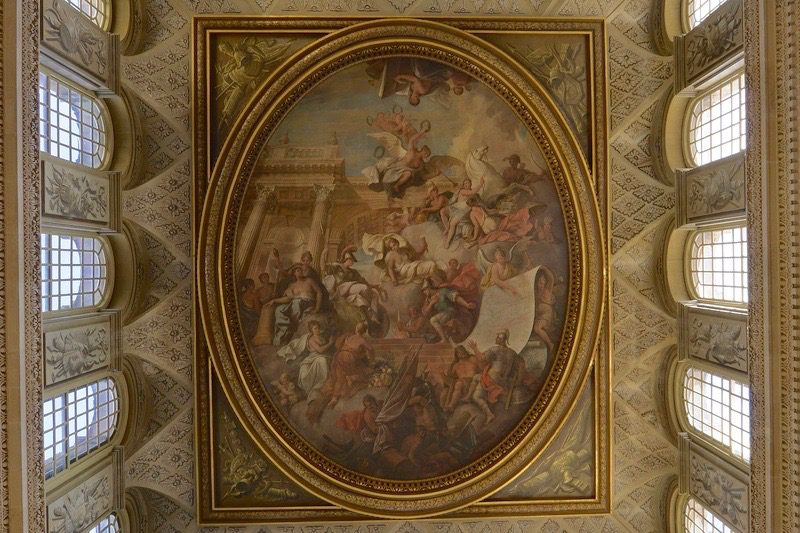
I noticed the intricate stone ornaments on the ceiling and the walls and asked a palace staff who was the artist and she told me it was the work of Grinling Gibbons.
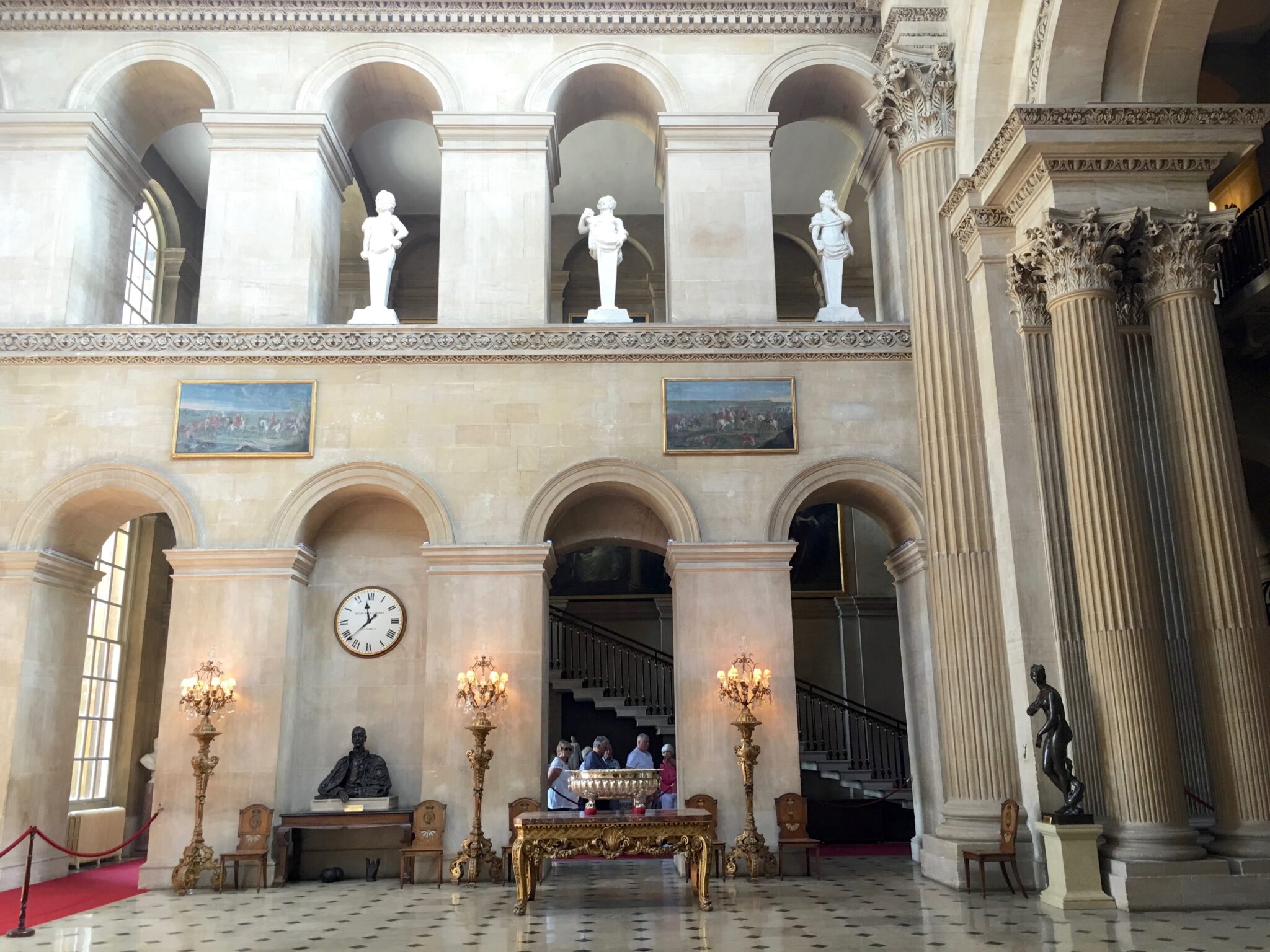 I was quite surprised and told her that I had no idea Gibbons did some work at Blenheim; that I’ve seen his woodcarvings and stone ornaments at The V&A Museum, St. Paul’s Cathedral and Kensington Palace Orangery but there’s nothing more magnificently crafted than his works at Blenheim. (She actually prompted me to look for a biography of Gibbons.) 🙂 Despite its immense size, The Great Hall is merely a vast anteroom to the Saloon – dining room of the palace.
I was quite surprised and told her that I had no idea Gibbons did some work at Blenheim; that I’ve seen his woodcarvings and stone ornaments at The V&A Museum, St. Paul’s Cathedral and Kensington Palace Orangery but there’s nothing more magnificently crafted than his works at Blenheim. (She actually prompted me to look for a biography of Gibbons.) 🙂 Despite its immense size, The Great Hall is merely a vast anteroom to the Saloon – dining room of the palace.

A staff suggested that we should do the “Churchill Exhibition” first before joining any tours within the palace. It is a dedicated exhibition to give visitors a real sense of the great war-time leader and most famous member of the Churchill family. It was opened last year to mark the 50th anniversary of Sir Winston Churchill’s death. This exhibit is incredible and worth a ten tale for another day.
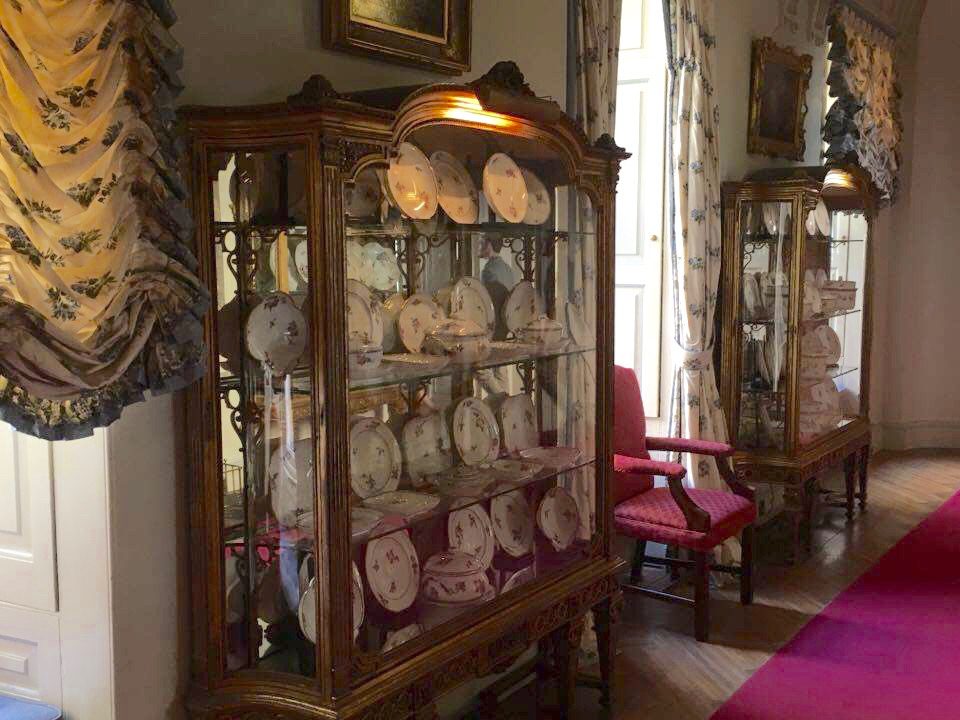 On the way to the state rooms after the Churchill Exhibition, we passed through a long corridor decorated with stag’s antlers on either side, and also lined with china cabinets showcasing Blenheim’s antique chinaware collections.
On the way to the state rooms after the Churchill Exhibition, we passed through a long corridor decorated with stag’s antlers on either side, and also lined with china cabinets showcasing Blenheim’s antique chinaware collections.
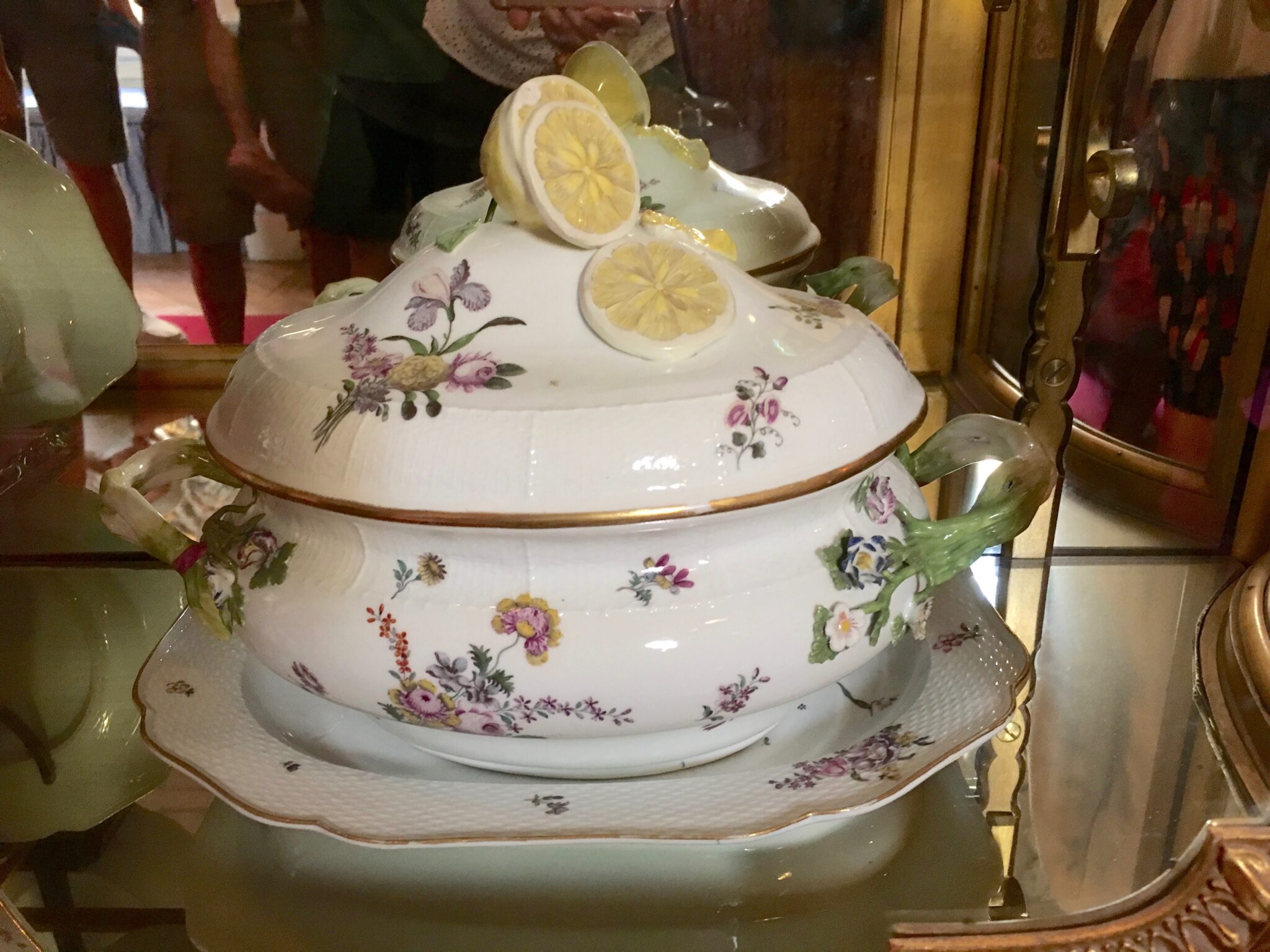
We reached the Green Drawing Room filled with exquisite collection of art and furniture that adorn the room. There’s a life-size portrait of the 4th Duke of Marlborough, wearing his robes of the Order of the Garter.
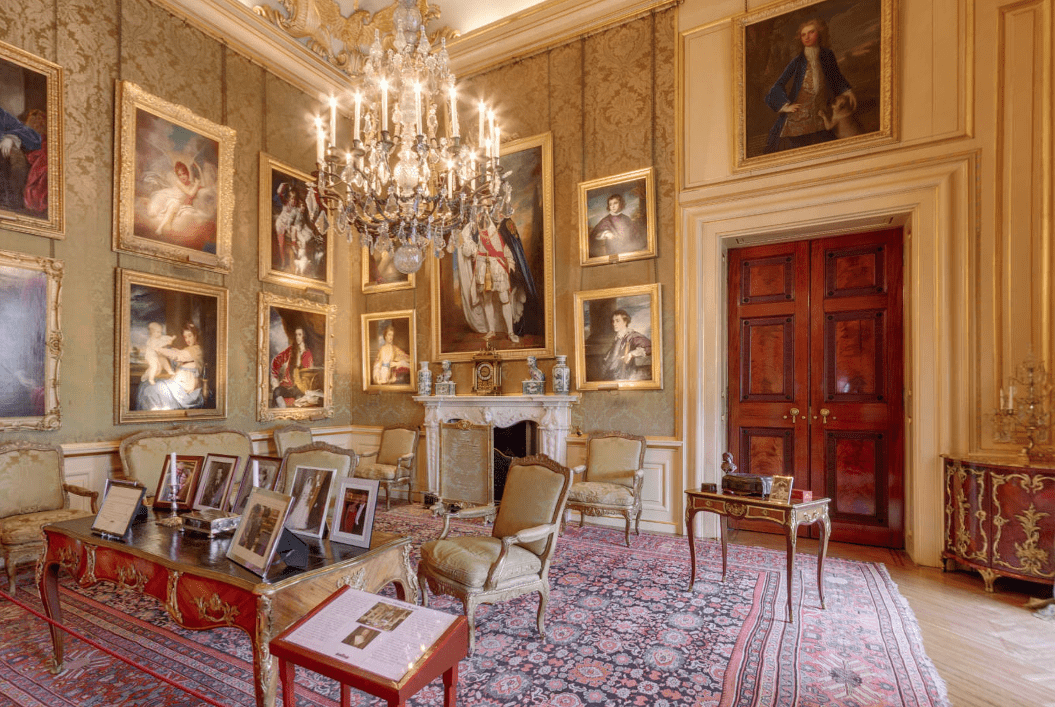 The most astonishing feature of this room is the 24k gold gilded ceiling.
The most astonishing feature of this room is the 24k gold gilded ceiling.
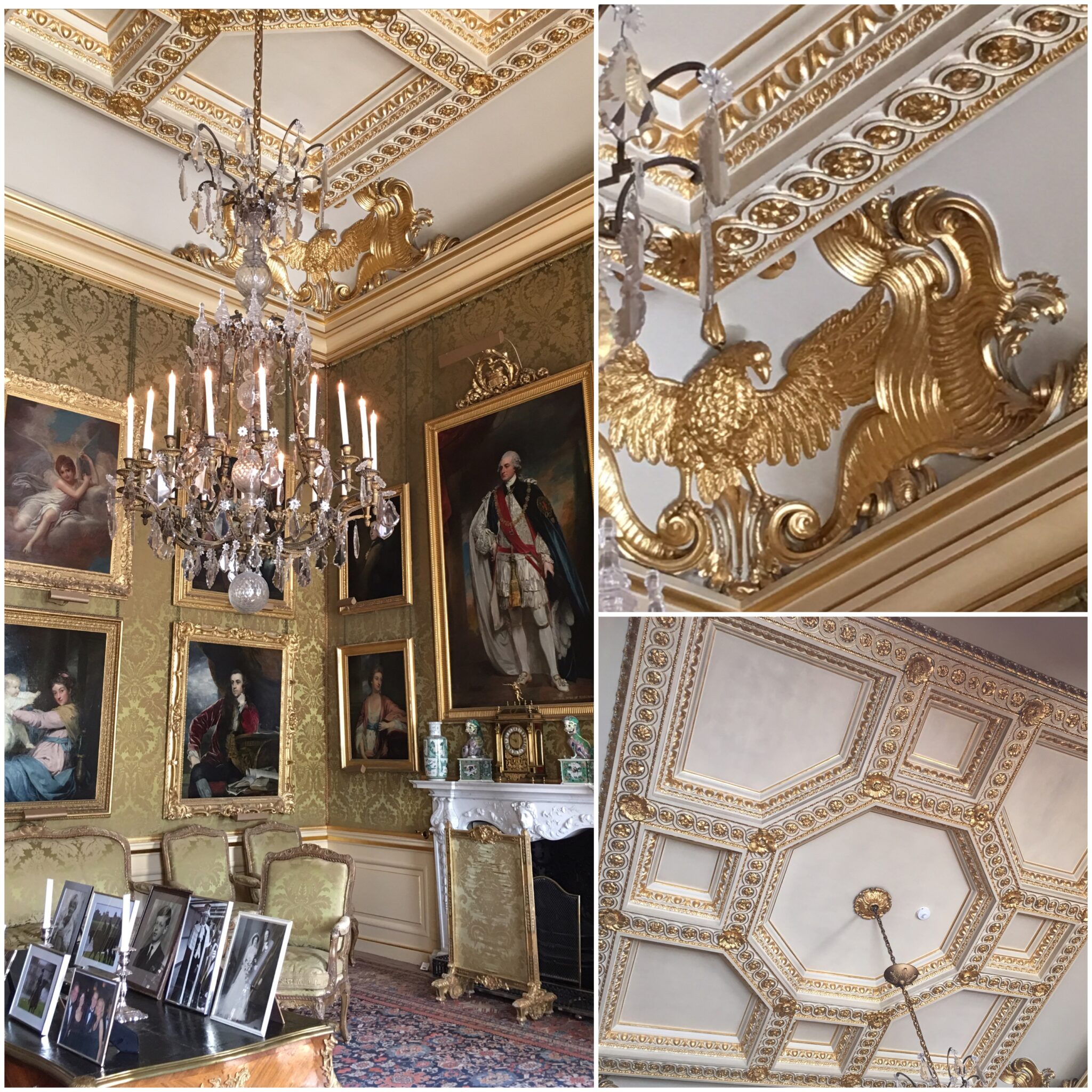
We continued on to the Red Drawing Room, filled with enviable collection of family portraits by famous 18th and 19th century artists, and some stunning furnitures by Thomas Chippendale, a London cabinet maker and furniture designer in the mid-Georgian, English Rocco, and Neoclassical styles.
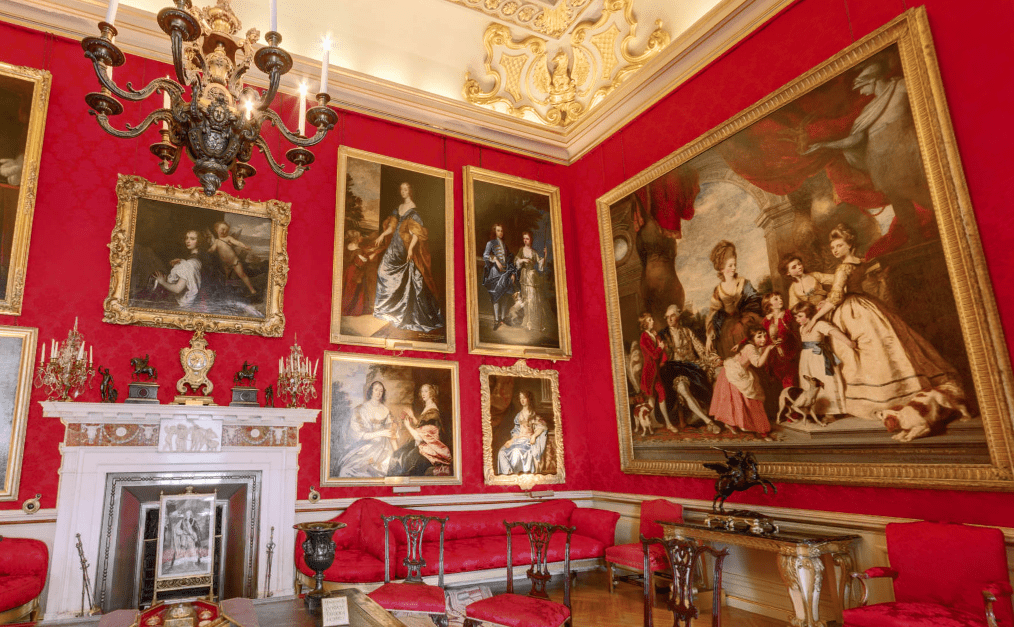
The portrait of the 9th Duke and his family is my favourite artwork in the Red Drawing Room. The duke and his wife, American railway heiress Consuelo Vanderbilt, had the most extraordinary marriage in the Gilded Age. Theirs was a marriage not for love but for money — a real ‘cash for class’ deal. The Marlboroughs were running out of money as a result of the palace maintenance, and Alva Vanderbilt, Consuelo’s mother, dreamt of having a duchess’s coronet for her family so she married off her daughter to the 9th duke. In her biography “The Glitter and the Gold by Consuelo Vanderbilt”, the duchess shared a story of how her mother locked her up in a room for several days until she agreed to marry the duke. The $2.5 million dowry she brought to England (approximately $66 million in today’s money) helped saved Blenheim Palace and the entire estate. Sadly, they had an extremely unhappy marriage; they hated each other but still managed to fulfil their obligation by producing an heir and a spare. She ended up leaving the duke and wanted to divorce him which was a bold action at the time especially when divorce was very difficult to achieve under English law. It shocked the English aristocracy, and it was socially devastating so pressure against the divorce was placed on Consuelo and the Duke from the King, the Vanderbilts, Winston Churchill and other members of the Churchill family. Because of their difficulties in obtaining a divorce, the Duke and Duchess of Marlborough decided on a formal separation and joint custody of their sons, and eventually they were granted a divorce in 1921. Sorry I digress . . . I love this tidbit about the 9th Duke who was responsible for opening the palace to the public in 1950. 🙂 Well, back to the palace tour.
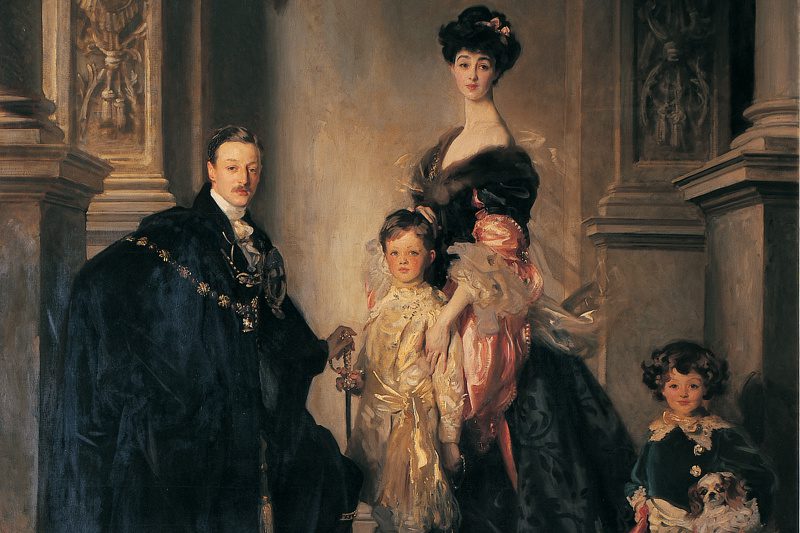
Adjacent to the Red Drawing Room is the Green Writing Room with the most famous “Blenheim Tapestry” depicting the 1st Duke of Marlborough in triumph accepting the French Marshall Tallard’s surrender at the Battle of Blenheim.
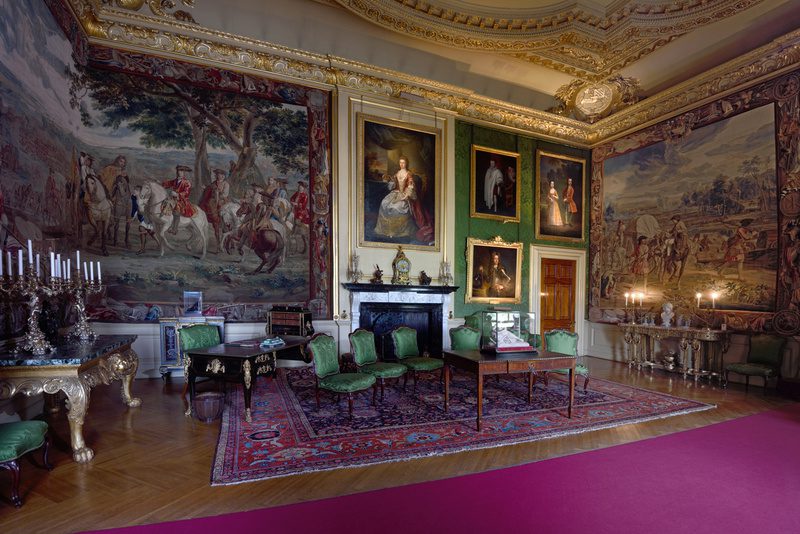 The Duke appears in all of the tapestries around the Palace, and he is easily spotted because of the red coat with gold buttons and gold spurs, and he also carried in his hand the Baton of Office. This room has a beautiful ceiling gilded with 9k gold.
The Duke appears in all of the tapestries around the Palace, and he is easily spotted because of the red coat with gold buttons and gold spurs, and he also carried in his hand the Baton of Office. This room has a beautiful ceiling gilded with 9k gold.
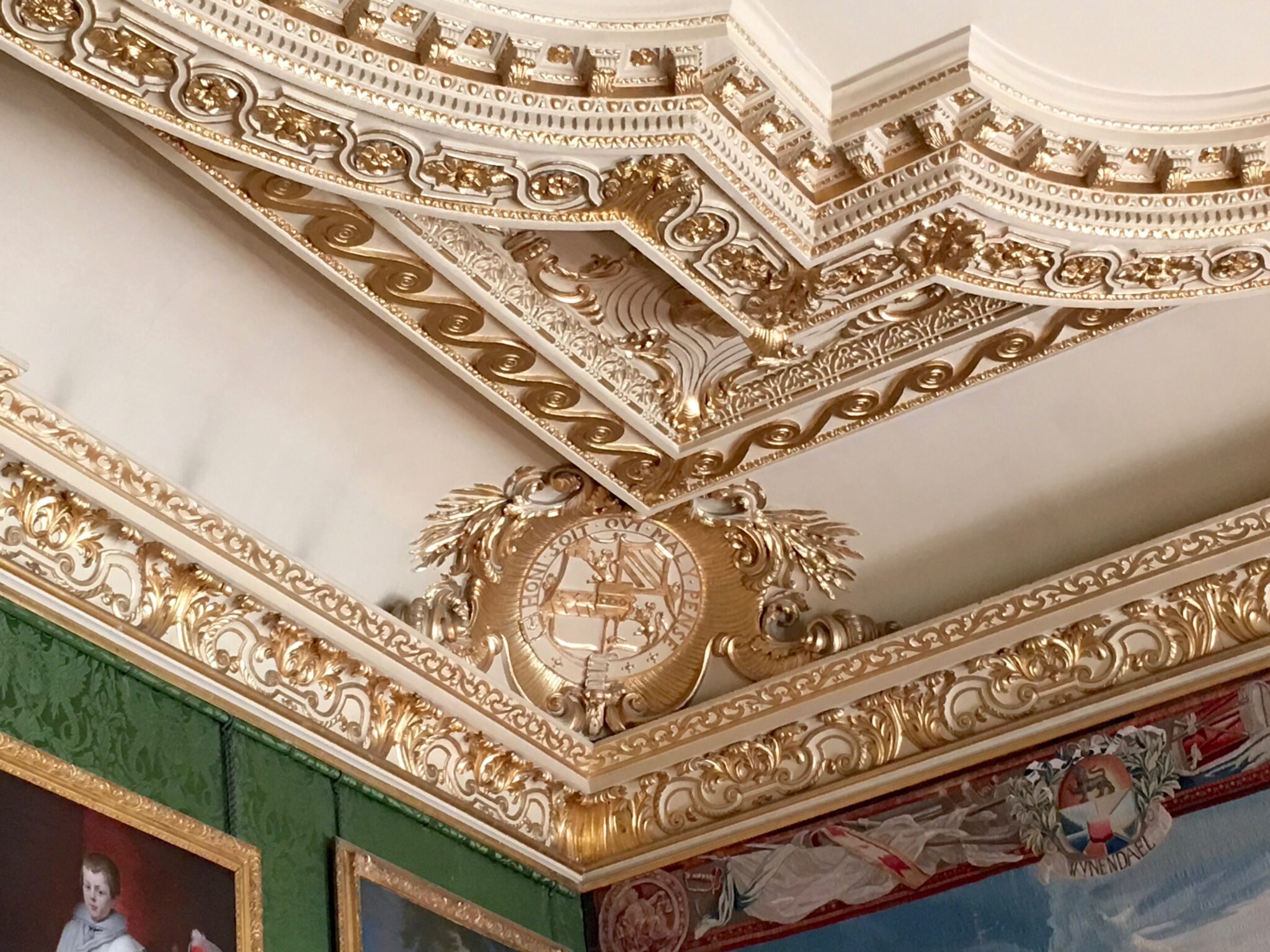
The rooms are all interconnected, and seen directly from the Green Writing Room is the “Saloon.” The Saloon is entered into either directly from the Great Hall, the Green Writing Room or the Library. From the Great Hall, the guests will pass under a large stone archway with the coat of arms of Queen Anne carved in stone by Grinling Gibbons to honor the monarch who made Blenheim Palace possible.
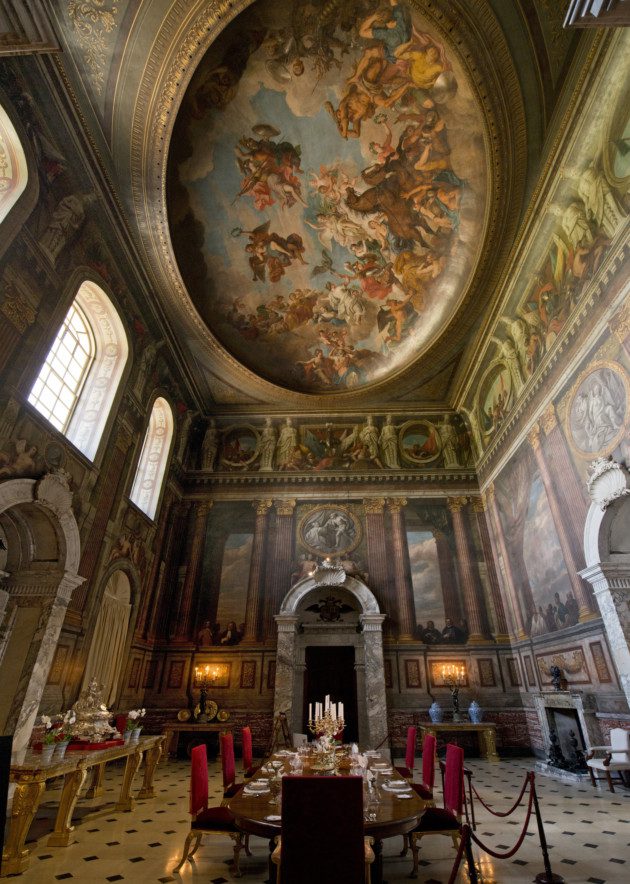
The Saloon is basically the state dining room and now only used once a year by the current Marlborough family (12th Duke) on Christmas Day. The Victorian table is set with a Minton service and silver gilt, and can sit up to 40 people.
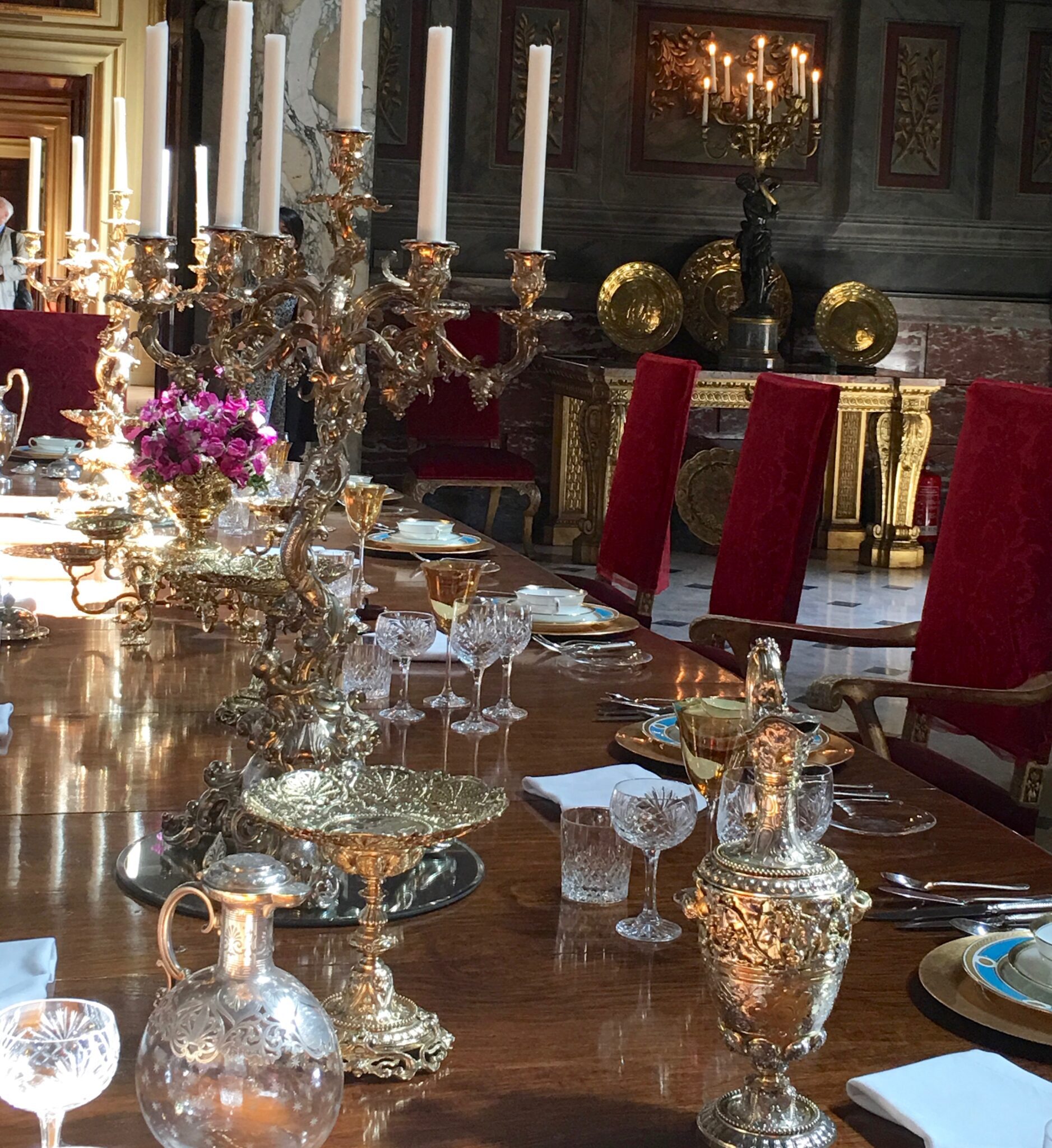 The stunning feature of note is the Saloon’s dome ceiling painted by Louis Laguerre representing Peace. The artist also painted the murals on the walls around the the room showing famous personalities including his self-portrait.
The stunning feature of note is the Saloon’s dome ceiling painted by Louis Laguerre representing Peace. The artist also painted the murals on the walls around the the room showing famous personalities including his self-portrait.
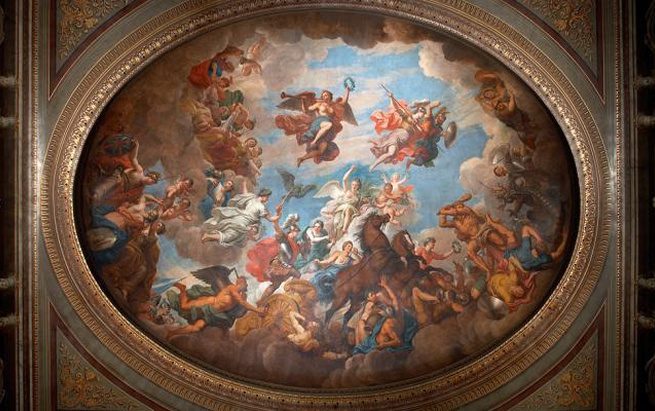
There’s a huge 110 lbs silver centerpiece located on a side table of the Saloon depicting the 1st Duke on his horse after the Battle of Blenheim writing the famous dispatch to the Duchess of his victory over the French. Apparently, Consuelo always placed this on the center table at the Saloon because she hated the sight of her husband and it prevented her from looking at him during meal times.
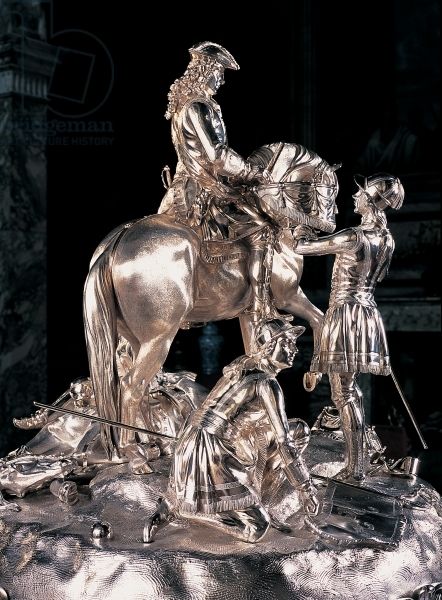
From the Saloon we entered into the Long Library designed by Sir Christopher Wren (the famous English mathematician – not an architect or engineer – who also designed St. Paul’s Cathedral), and was intended as a picture gallery. This room is 180 feet (55 m) long with very high ceilings that feature a series of domes and has several other distinct features.

There is large full length statue of Queen Anne by John Michael Rysbrack with an inscription noting the close ties between the monarch and the 1st Duke and Duchess of Marlborough.
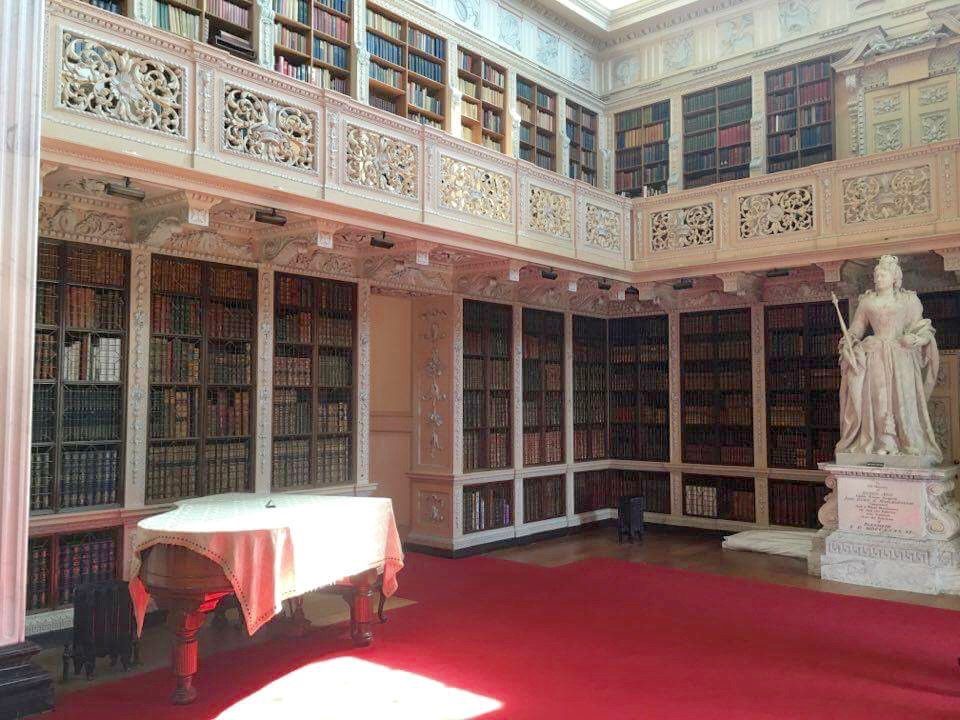 The Marlborough collection has over 10,000 volumes stacked on book shelves from ground to ceiling.
The Marlborough collection has over 10,000 volumes stacked on book shelves from ground to ceiling.
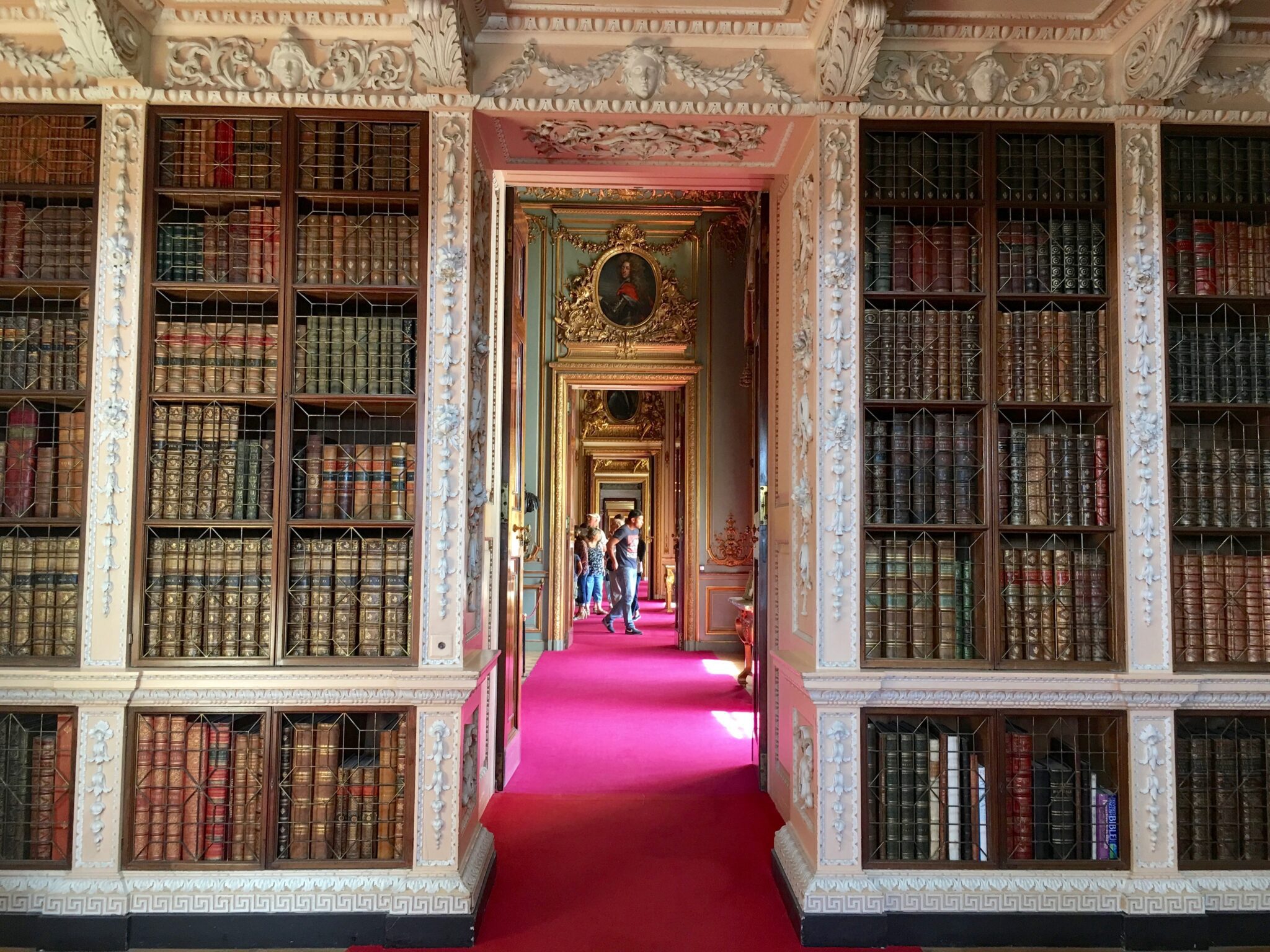 Libraries are my happy place. I have always enjoyed visiting libraries (The British Library is my all time favourite). While at Blenheim I told Jared that I can imagine myself sitting in the couch by the fireplace reading books for hours on end. I simply couldn’t resist having a photograph taken of myself in this delightful room. 😉
Libraries are my happy place. I have always enjoyed visiting libraries (The British Library is my all time favourite). While at Blenheim I told Jared that I can imagine myself sitting in the couch by the fireplace reading books for hours on end. I simply couldn’t resist having a photograph taken of myself in this delightful room. 😉
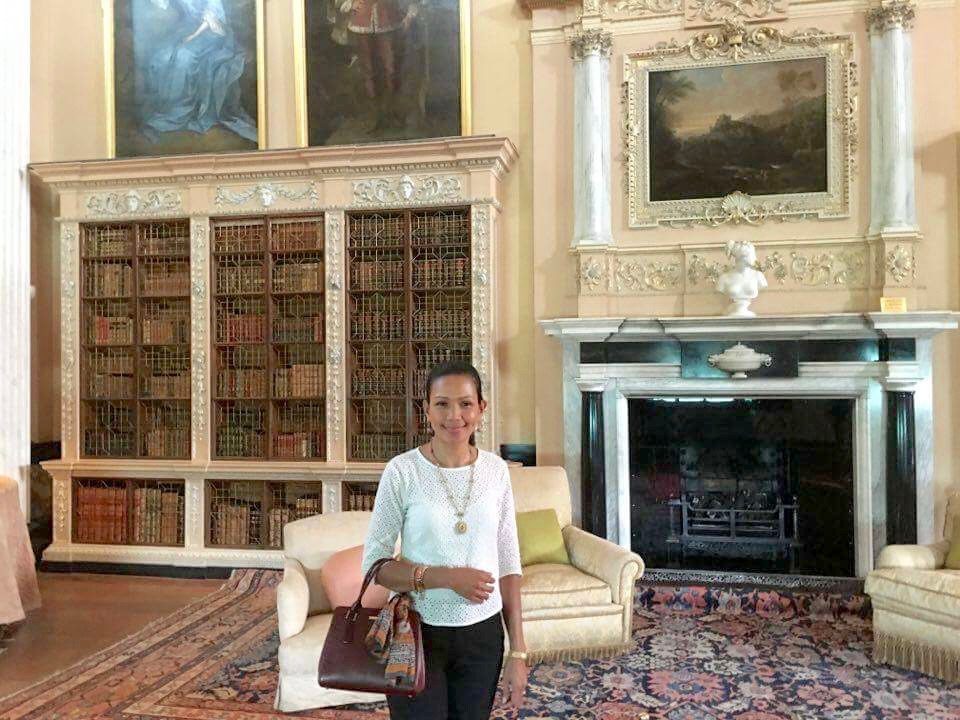 At the north end of this hall is a large organ that was commissioned by Henry Willis & Sons.
At the north end of this hall is a large organ that was commissioned by Henry Willis & Sons.
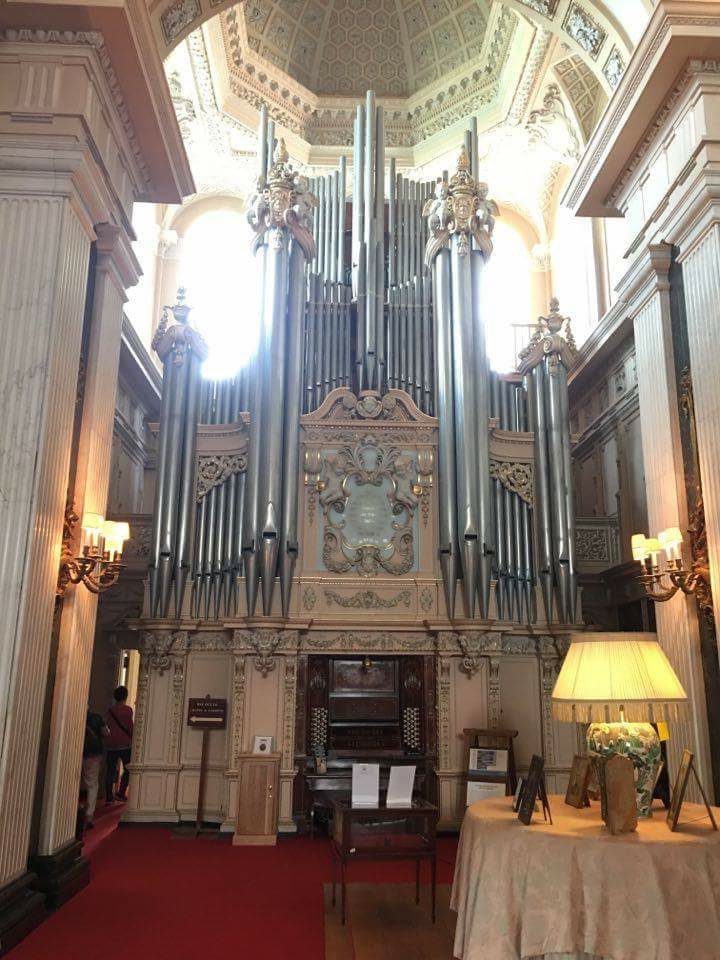
It is the largest pipe organ located in a private home in Europe.
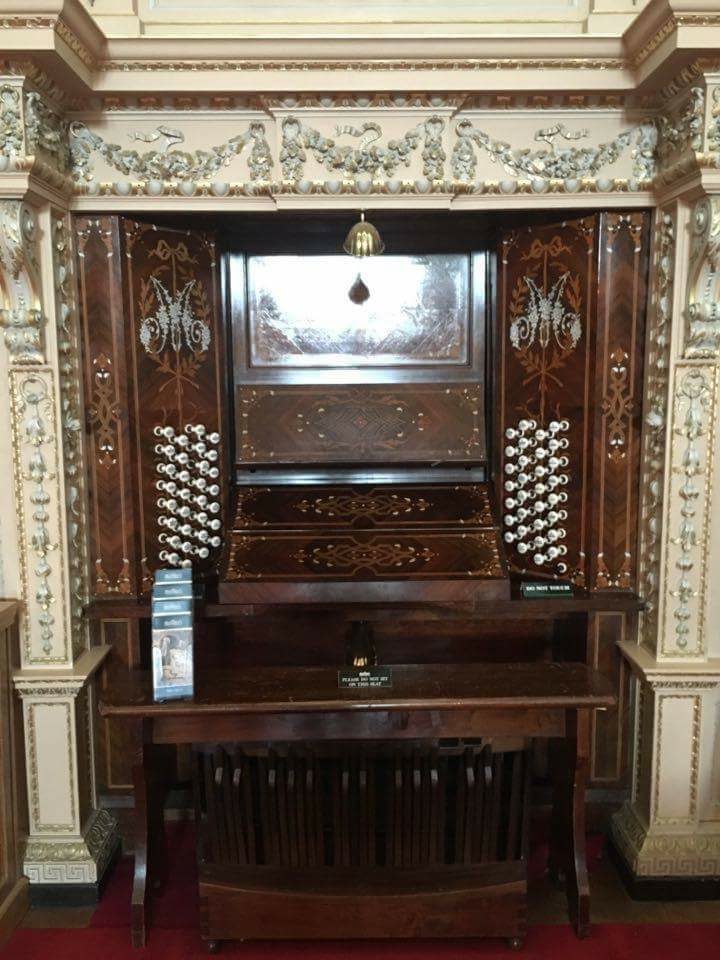
The organ is still in excellent condition and played very frequently especially on Friday and Sunday afternoons – much to the delight of visitors.
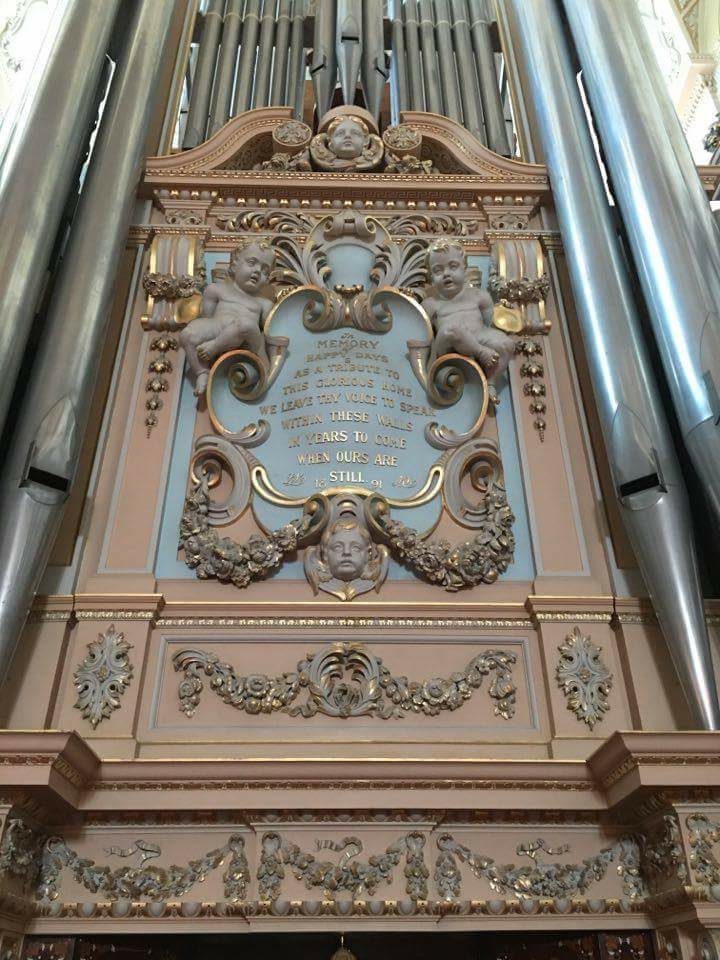
From the Long Library, there is access down a colonnade to the Chapel.
 The Chapel was completed in 1732, 11 years after the death of the 1st Duke, and it contains the tomb of the 1st Duke and Duchess of Marlborough, and their two sons but sadly their four daughters are not mentioned on the memorial – not sure where they were buried. When the 1st Duke died in 1722 he was buried in Westminster Abbey and when the Duchess died in 1744 his remains were re-interred at the Chapel. Successive Dukes and their wives (there’s loads of them since the Marlborough men marry well, and they marry often, sometimes up 4 times) are also interred in the vault beneath the chapel. Other members of the Churchill family including the late Prime Minister are interred in St. Martin’s Parish Church yard at Bladon, just 2 miles from the palace.
The Chapel was completed in 1732, 11 years after the death of the 1st Duke, and it contains the tomb of the 1st Duke and Duchess of Marlborough, and their two sons but sadly their four daughters are not mentioned on the memorial – not sure where they were buried. When the 1st Duke died in 1722 he was buried in Westminster Abbey and when the Duchess died in 1744 his remains were re-interred at the Chapel. Successive Dukes and their wives (there’s loads of them since the Marlborough men marry well, and they marry often, sometimes up 4 times) are also interred in the vault beneath the chapel. Other members of the Churchill family including the late Prime Minister are interred in St. Martin’s Parish Church yard at Bladon, just 2 miles from the palace.
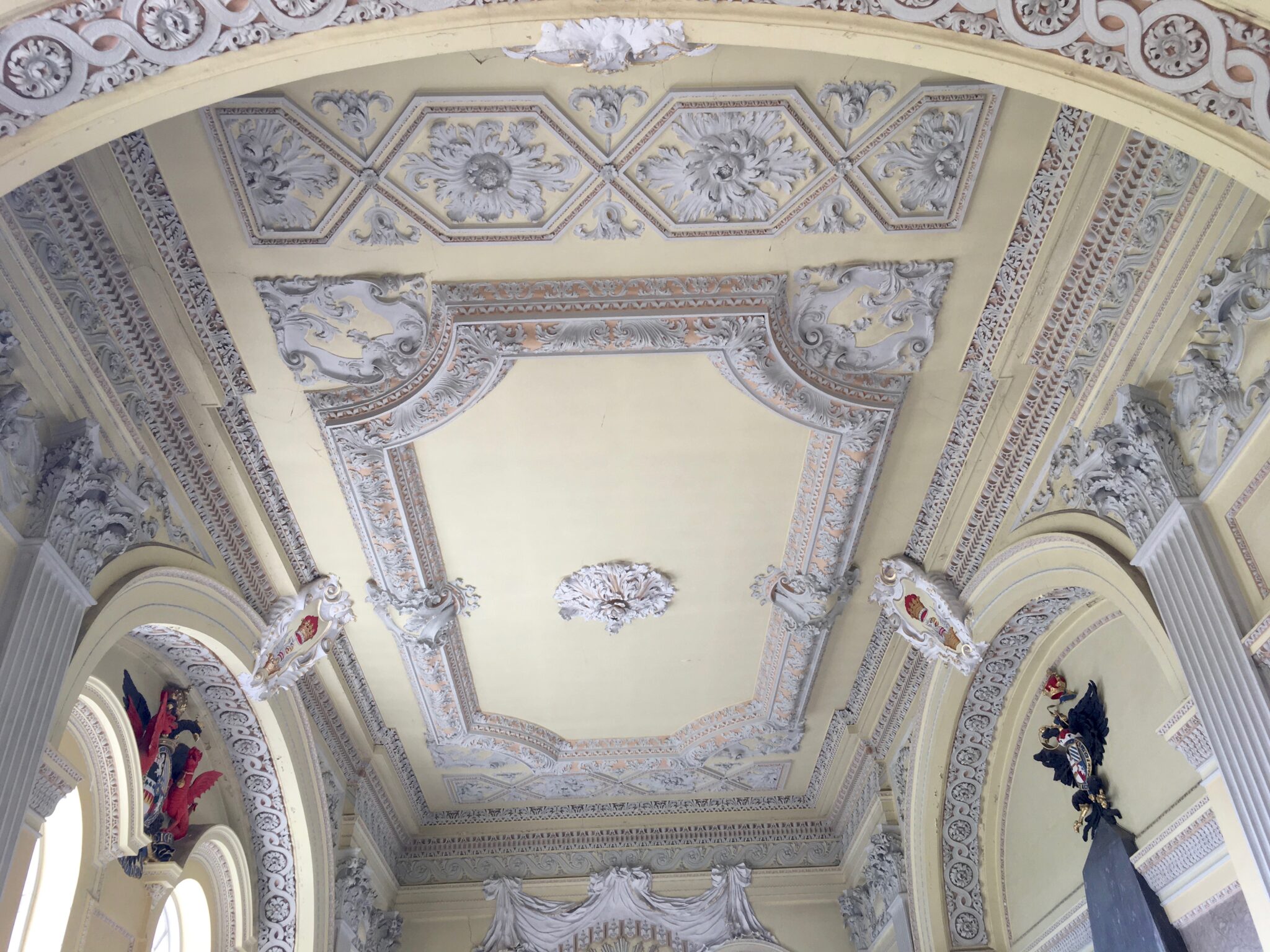 The Chapel’s ceiling has very pretty stone ornaments.
The Chapel’s ceiling has very pretty stone ornaments.
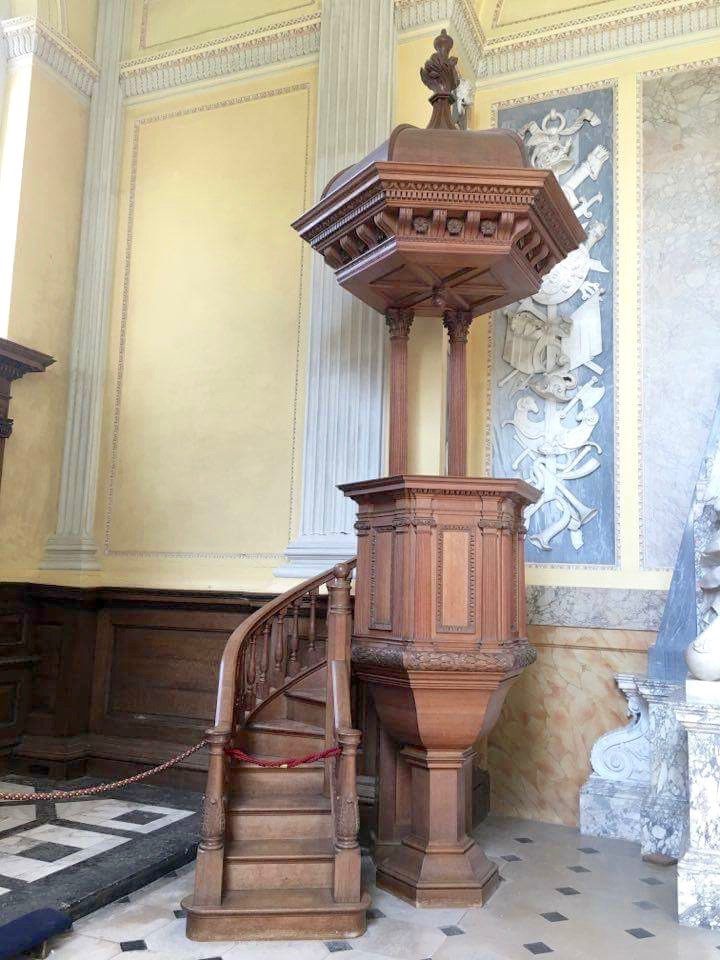
Finally, we ended the house tour and went out to the courtyard.
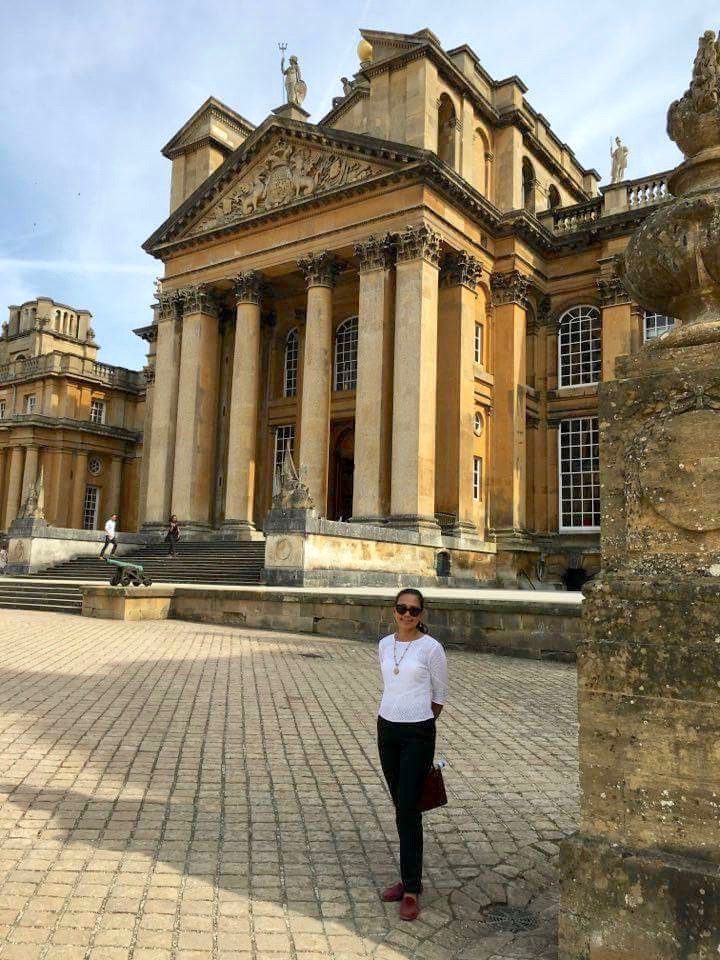
We visited the Formal Gardens, The Column of Victory, Italian Garden, Rose Garden, Secret Garden, and some other areas of the park. We walked, got on the miniature train around the estate for hours but there wasn’t much time to see everything in a day. Regrettably, we didn’t even get to do the ‘Upstairs’ and ‘Downstairs’ tours, the exhibition at the stables showcasing the military skills of Winston Churchill and his famous descendant, the 1st Duke of Marlborough. It is a massive property with three dozen outbuildings that sit on Blenheim’s 2,000-acre park, and there are another 200 cottages/dwellings within the adjacent 11,000-acre estate – an entire day isn’t enough to explore everything. They have a miniature train and other mode of transport to take the guests around but there’s also an option of exploring the estate on foot — they have free maps that the visitors can get if they’d rather walk.
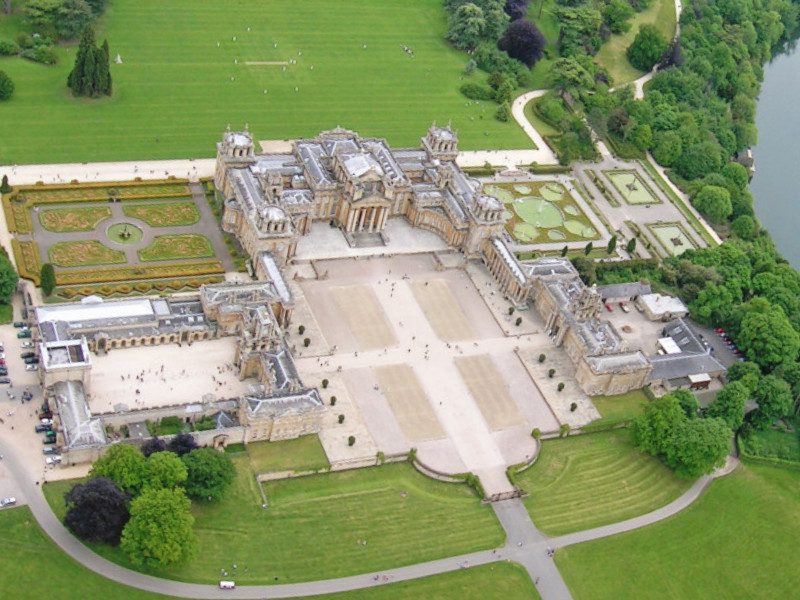
While we were walking around the palace Jared said to me, “Can you imagine living in this huge house and managing this massive property? I don’t think I wanna live in a place like this. It will be a lot of headache.” I responded by saying, “Well, you know what? If you’re the duke then of course, you’ll hire a property manager to do the job for you. You don’t have to worry about anything except to produce an heir; you don’t have to worry about paying the bills, or calculating the costs of the building maintenance, employment and wages of servants, and all the other trappings of aristocracy. All you have to do is sit down and relax, travel to exotic places during the winter months to get away from the harsh British winter.” And I added, “Did you know that’s the reason why the 11th Duke of Marlborough changed his wife like he would change his outfits?” Haha!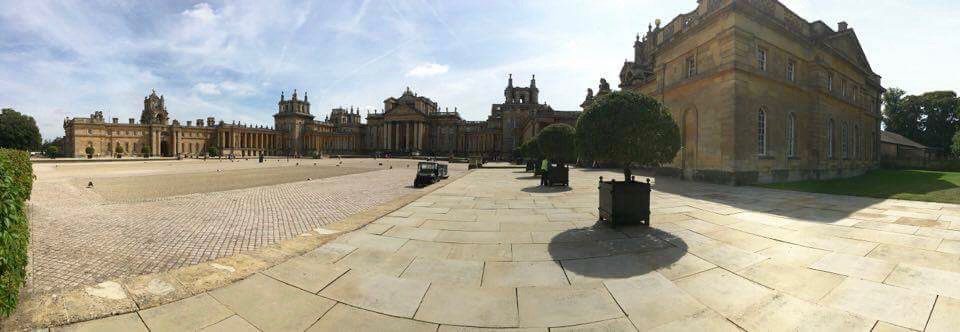 After visiting this place, I must say that it is one of Britain’s finest palaces. I’ve been to Buckingham Palace a few times, and visited Windsor Castle and other residences of the monarch and none of them compares in grandeur and magnificence of Blenheim Palace. It has been designated by United Nations Educational, Scientific and Cultural Organisation (UNESCO) as a site worthy of World Heritage status in 1987, and it truly is worthy of a visit. We’ll definitely go back to do all the other tours and exhibitions that we didn’t get to do, and to simply revel in its rich cultural heritage.
After visiting this place, I must say that it is one of Britain’s finest palaces. I’ve been to Buckingham Palace a few times, and visited Windsor Castle and other residences of the monarch and none of them compares in grandeur and magnificence of Blenheim Palace. It has been designated by United Nations Educational, Scientific and Cultural Organisation (UNESCO) as a site worthy of World Heritage status in 1987, and it truly is worthy of a visit. We’ll definitely go back to do all the other tours and exhibitions that we didn’t get to do, and to simply revel in its rich cultural heritage.
Note:
Please see the room where Churchill was born and the memorial garden created to mark his 50th death anniversary:
And also the magnificent palace grounds: Blenheim Palace Gardens